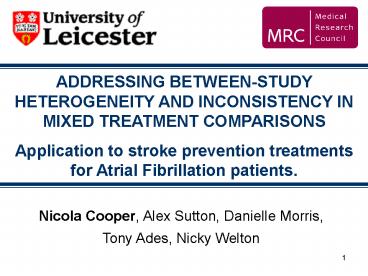ADDRESSING BETWEENSTUDY HETEROGENEITY AND INCONSISTENCY IN MIXED TREATMENT COMPARISONS - PowerPoint PPT Presentation
1 / 12
Title:
ADDRESSING BETWEENSTUDY HETEROGENEITY AND INCONSISTENCY IN MIXED TREATMENT COMPARISONS
Description:
Application to stroke prevention treatments for Atrial Fibrillation patients. ... prevention treatments in individuals with non-rheumatic Atrial Fibrillation. ... – PowerPoint PPT presentation
Number of Views:72
Avg rating:3.0/5.0
Title: ADDRESSING BETWEENSTUDY HETEROGENEITY AND INCONSISTENCY IN MIXED TREATMENT COMPARISONS
1
ADDRESSING BETWEEN-STUDY HETEROGENEITY AND
INCONSISTENCY IN MIXED TREATMENT COMPARISONS
Application to stroke prevention treatments for
Atrial Fibrillation patients.
Nicola Cooper, Alex Sutton, Danielle Morris,
Tony Ades, Nicky Welton
2
MIXED TREATMENT COMPARISON
- MTC - extends meta-analysis methods to enable
comparisons between all relevant comparators in
the clinical area of interest.
Option 1 Two pairwise M-A analyses (A v C, B v
C) Option 2 MTC (A v B v C) provides probability
each treatment is the best of all treatments
considered for treating condition x.
A
B
C
3
HETEROGENIETY INCONSISTENCY
- As with M-A need to explore potential sources of
variability - i) Heterogeneity - variation in treatment
effects between trials within pairwise
contrasts, and - ii) Inconsistency - variation in treatment
effects between pairwise contrasts - Random effect - allows for heterogeneity but does
NOT ensure inconsistency is addressed - Incorporation of study-level covariates can
reduce both heterogeneity and inconsistency by
allowing systematic variability between trials to
be explained
4
OBJECTIVE
- To extend the MTC framework to allow for the
incorporation of study-level covariates - 3 models
- Different regression coefficient for each
treatment - Exchangeable regression coefficient
- Common regression (slope) coefficient
5
EXAMPLE NETWORK
2
A
B
Stroke prevention treatments for Atrial
Fibrillation patients (18 trials) A Placebo B
Low dose anti-coagulant C Standard dose
anti-coagulant D Standard dose aspirin
7
2
1
4
10
C
D
Covariate publication date (proxy for factors
relating to change in clinical practice over
time)
6
MTC random effects model
rjk observed number of individuals experiencing
an event out of njk pjk probability of an
event ?jb log odds of an event in trial j on
baseline treatment b ?jbk trial-specific
log odds ratio of treatment k relative to
treatment b dbk pooled log odds ratios s2
between study variance
7
MODEL 1 Different regression coefficient for
each treatment
NOTE Relative treatment effects for the active
treatment versus placebo are allowed to vary
independently with covariate thus, ranking of
effectiveness of treatments allowed to vary for
different covariate values
8
MODEL 2 Exchangeable regression coefficient
9
MODEL 3 Common regression (slope) coefficient
Note Relative treatment effects only vary with
the covariate when comparing active treatments to
placebo.
10
FULL 17 TRT NETWORK
17 treatments 25 trials 60 data points
11
FULL 17 TRT NETWORK ISSUES
- Model becomes over-specified as number of
parameters to be estimated approaches or exceeds
the number of data points available - e.g. Model 1 - requires estimation of 25
baselines, 16 treatment means, 16 regression
coefficients, between-study variance ( random
effects). - May be sensible to consider treatments within
classes - e.g. Anti-coagulant, Anti-platelet, Both
- Best fitting model exchangeable treatment x
covariate effects by class - Reference Cooper NJ, Sutton AJ, Morris D, Ades
AE, Welton NJ. Addressing between-study
heterogeneity and inconsistency in mixed
treatment comparisons Application to stroke
prevention treatments in individuals with
non-rheumatic Atrial Fibrillation. Submitted to
Statistics in Medicine
12
DISCUSSION
- Number of different candidate models -
especially for large treatment networks often
with limited data - Need to be aware of limitations posed by
available data importance of ensuring model
interpretability and relevance to clinicians - Uncertainty in the regression coefficients and
the treatment differences not represented on
graphs (which can be considerable) - Results from MTC increasingly used to inform
economic decision models. Incorporation of
covariates may allow separate decisions to be
made for individuals with different
characteristics































